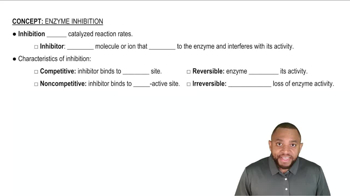What general effects would you expect the following changes to have on the rate of an enzyme-catalyzed reaction for an enzyme that has its maximum activity at body temperature (about 37°C)?
c. Adding an organic solvent, such as methanol
 Verified step by step guidance
Verified step by step guidance


What general effects would you expect the following changes to have on the rate of an enzyme-catalyzed reaction for an enzyme that has its maximum activity at body temperature (about 37°C)?
c. Adding an organic solvent, such as methanol
What general effects would you expect the following changes to have on the rate of an enzyme-catalyzed reaction for an enzyme that has its maximum activity at body temperature (about 37°C)?
c. Adding an oxidizing agent, such as hydrogen peroxide
The text discusses three forms of enzyme inhibition: uncompetitive inhibition, competitive inhibition, and irreversible inhibition.
b. What kinds of bonds are formed between an enzyme and each of these three kinds of inhibitors?
What kind of inhibition (uncompetitive, competitive, or irreversible) is present in each of the following:
c. The antibiotic deoxycycline inhibits the bacterial enzyme collagenase, slowing bacterial growth. Deoxycycline does not fit into the active site of collagenase and binds elsewhere on the enzyme.
One mechanism by which lead exerts its poisonous effect on enzymes can be stopped by chelation therapy with EDTA. Describe this type of lead poisoning and explain why it is reversible.
The meat tenderizer used in cooking is primarily papain, a protease enzyme isolated from the fruit of the papaya tree. Why do you suppose papain is so effective at tenderizing meat?